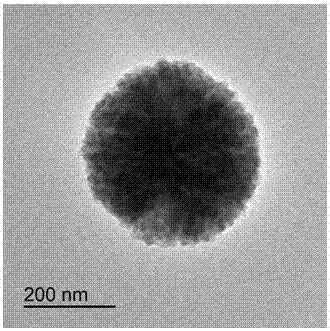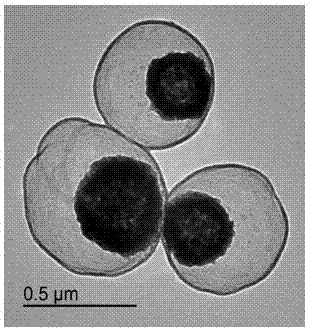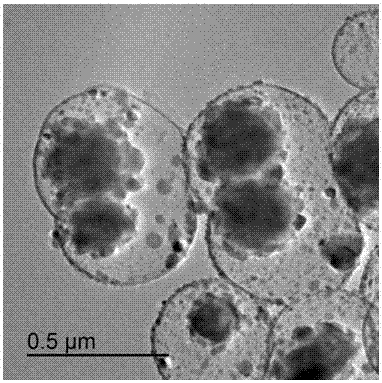Preparing method of hollow magnetic carbon nanospheres with MOFs growing inside in confinement mode
A technology of magnetic carbon and nanospheres, applied in the manufacture of magnetic materials, magnetic objects, inductors/transformers/magnets, etc., can solve the problems of small size, non-magnetic MOFs, poor stability, etc., to improve catalytic performance and morphology. Uniform and stable structure
- Summary
- Abstract
- Description
- Claims
- Application Information
AI Technical Summary
Problems solved by technology
Method used
Image
Examples
Embodiment 1
[0042] 1. Preparation of magnetic carbon nanocages:
[0043] 3.6 g FeCl 3 ·6H 2 O, 90 ml of ethylene glycol, 10 ml of ethanol and 2.4 g of sodium acetate were mixed, mechanically stirred at room temperature for 30 min, the mixed solution was transferred to a reactor, and hydrothermally reacted at 200 °C for 10 h. After the reaction was completed, it was washed by centrifugation and dried to obtain 200 nm Fe 3 o 4 ball.
[0044] Mix 75 ml of ethanol, 30 ml of deionized water and 3 ml of ammonia water, and mix 0.3 g Fe 3 o 4 The spheres were dispersed into the mixed solution; 0.6 g tetraethylorthosilicate (TEOS) was added dropwise at a constant speed to the 3 o 4 In the mixed solution, stir mechanically at room temperature and react for 10 min to form a core-shell structure of Fe 3 o 4 @SiO 2 nanospheres.
[0045] 1 ml of formaldehyde solution and 0.5 g of resorcinol were added to the above reaction system, and the reaction was carried out under mechanical stirring fo...
Embodiment 2
[0054] 1. Preparation of magnetic carbon nanocages:
[0055] 3.6 g FeCl 3 ·6H 2 O, 90 ml of ethylene glycol, 10 ml of ethanol and 2.4 g of sodium acetate were mixed, mechanically stirred at room temperature for 30 min, the mixed solution was transferred to a reactor, and hydrothermally reacted at 200 °C for 10 h. After the reaction was completed, it was washed by centrifugation and dried to obtain 200 nm Fe 3 o 4 ball.
[0056] Mix 75 ml of ethanol, 30 ml of deionized water and 3 ml of ammonia water, and mix 0.3 g Fe 3 o 4 The spheres were dispersed into the mixed solution; 0.6 g tetraethylorthosilicate (TEOS) was added dropwise at a constant speed to the 3 o 4In the mixed solution, stir mechanically at room temperature and react for 10 min to form a core-shell structure of Fe 3 o 4 @SiO 2 nanospheres.
[0057] 1 ml of formaldehyde solution and 0.5 g of resorcinol were added to the above reaction system, and the reaction was carried out under mechanical stirring for...
Embodiment 3
[0066] 1. Preparation of magnetic carbon nanocages:
[0067] 3.6 g FeCl 3 ·6H 2 O, 90 ml of ethylene glycol, 10 ml of ethanol and 2.4 g of sodium acetate were mixed, mechanically stirred at room temperature for 30 min, the mixed solution was transferred to a reactor, and hydrothermally reacted at 200 °C for 10 h. After the reaction was completed, it was washed by centrifugation and dried to obtain 200 nm Fe 3 o 4 ball.
[0068] Mix 75 ml of ethanol, 30 ml of deionized water and 3 ml of ammonia water, and mix 0.3 g Fe 3 o 4 The spheres were dispersed into the mixed solution; 0.6 g tetraethylorthosilicate (TEOS) was added dropwise at a constant speed to the 3 o 4 In the mixed solution, stir mechanically at room temperature and react for 10 min to form a core-shell structure of Fe 3 o 4 @SiO 2 nanospheres.
[0069] 1 ml of formaldehyde solution and 0.5 g of resorcinol were added to the above reaction system, and the reaction was carried out under mechanical stirring fo...
PUM
| Property | Measurement | Unit |
|---|---|---|
| diameter | aaaaa | aaaaa |
| thickness | aaaaa | aaaaa |
| pore size | aaaaa | aaaaa |
Abstract
Description
Claims
Application Information
 Login to View More
Login to View More - R&D
- Intellectual Property
- Life Sciences
- Materials
- Tech Scout
- Unparalleled Data Quality
- Higher Quality Content
- 60% Fewer Hallucinations
Browse by: Latest US Patents, China's latest patents, Technical Efficacy Thesaurus, Application Domain, Technology Topic, Popular Technical Reports.
© 2025 PatSnap. All rights reserved.Legal|Privacy policy|Modern Slavery Act Transparency Statement|Sitemap|About US| Contact US: help@patsnap.com



